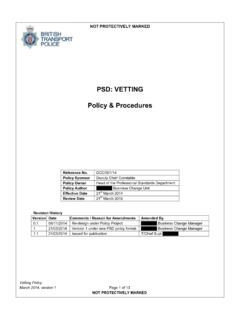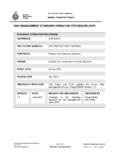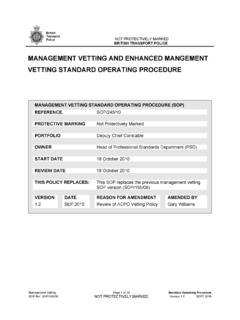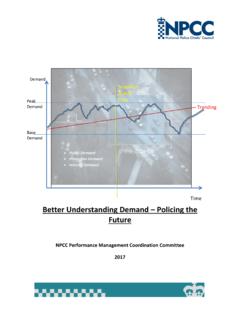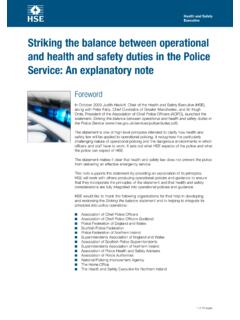Transcription of RISK MANAGEMENT STANDARD OPERATING PROCEDURE …
1 BRITISH TRANSPORT POLICE NOT PROTECTIVELY MARKED BRITISH TRANSPORT POLICE Risk MANAGEMENT STANDARD OPERATING PROCEDURE Page 1 of 10 STANDARD OPERATING PROCEDURE SOP Ref: SOP/220/10 protective MARKING Version Date: July 2010 RISK MANAGEMENT STANDARD OPERATING PROCEDURE (SOP) STANDARD OPERATING PROCEDURE REFERENCE SOP/220/10 protective MARKING NOT PROTECTIVELY MARKED PORTFOLIO Finance and Corporate Services OWNER Director of Finance and Corporate Services START DATE 22 July 2010 REVIEW DATE April 2013 THIS POLICY REPLACES: This Policy and SOP updates the former Risk MANAGEMENT Policy ( Policy/038/06 Version ) VERSION DATE REASON FOR AMENDMENT AMENDED BY June 2010 Changes in the reporting structure for risk MANAGEMENT within BTP Doug Hanley Kay Black BRITISH TRANSPORT POLICE NOT PROTECTIVELY MARKED BRITISH TRANSPORT POLICE Risk MANAGEMENT STANDARD OPERATING PROCEDURE Page 2 of 10 STANDARD OPERATING PROCEDURE SOP Ref: SOP/220/10 protective MARKING Version Date: July 2010 CONTENTS 1.
2 INTRODUCTION ..3 2. Terms and Definitions ..3 Roles and Responsibilities ..4 3. PROCEDURES ..5 Identification of new risk ..5 Risk Assessment ..6 Risk Register ..6 Monitoring of Risk MANAGEMENT and Review of the Risk Risk Decisions ..7 Risk Closure and As Low as Reasonably Practicable ..8 REPORTING REQUIREMENTS ..9 4 COMPLIANCE ..10 BRITISH TRANSPORT POLICE NOT PROTECTIVELY MARKED BRITISH TRANSPORT POLICE Risk MANAGEMENT STANDARD OPERATING PROCEDURE Page 3 of 10 STANDARD OPERATING PROCEDURE SOP Ref: SOP/220/10 protective MARKING Version Date: July 2010 RISK MANAGEMENT PROCEDURES 1.
3 INTRODUCTION This document sets out procedures for identifying, assessing, monitoring, managing and reporting risk within British Transport Police (BTP). These procedures reflect the aims of BTP s Risk MANAGEMENT policy for the MANAGEMENT of identified risks at Strategic, Corporate, Area and Portfolio level. These procedures apply to England, Wales and Scotland, and apply to all BTP employees. 2. KNOWLEDGE Terms and Definitions Risk: An event or set of circumstances, with an uncertain likelihood or outcome, which would have a negative impact on BTP should it be realised. Opportunity: An event or set of circumstances, with an uncertain likelihood or outcome, which would have a positive impact on BTP should it be realised.
4 Impact: What the consequences of a risk happening would be. Probability: An estimate of the likelihood of a risk happening once identified. Risk Rating: The process by which the impact and probability of a risk are combined to give an overall risk rating. Risk Assessment: A summary of the causes and consequences of a risk which include an initial risk rating, and potential courses of action. Risk Register: Document recording identified risks . Controls: Those measures already in place to manage risk. Actions: Actions planned to manage risk. BRITISH TRANSPORT POLICE NOT PROTECTIVELY MARKED BRITISH TRANSPORT POLICE Risk MANAGEMENT STANDARD OPERATING PROCEDURE Page 4 of 10 STANDARD OPERATING PROCEDURE SOP Ref: SOP/220/10 protective MARKING Version Date: July 2010 More complete definitions of these terms are included in the glossary.
5 (Please see Appendix A) Roles and Responsibilities The Chief Constable is ultimately responsible for the MANAGEMENT of business risk within BTP. However, in practice, responsibility for risk in specific business areas is delegated to members of the Strategic Command Team (SCT) who may in turn delegate risk MANAGEMENT responsibilities. The key purpose of risk MANAGEMENT is to enable BTP to anticipate and respond to current and emergent threats through the active identification, assessment and monitoring of risk. The Director of Finance and Corporate Services (F&CS) is the SCT member with lead responsibility for Risk MANAGEMENT matters within BTP.
6 The Head of Risk MANAGEMENT and Insurance has responsibility for the BTP Risk MANAGEMENT Strategy, and reporting progress to SCT and the British Transport Police Authority (BTPA). The Risk MANAGEMENT Co-ordinator (RMC) is responsible for implementing the BTP Risk MANAGEMENT Strategy. The RMC maintains the Corporate and Strategic Risk Registers. Area Commanders and Departmental Heads are responsible for implementing risk MANAGEMENT arrangements in their respective Areas and Departments including the nomination of risk champions and representatives. Risk Champions are members of their respective SMT with responsibility for ensuring that risk MANAGEMENT issues are given due consideration and ensuring acceptable progress is made in managing risks .
7 They should normally be a Superintendent or police staff equivalent. BRITISH TRANSPORT POLICE NOT PROTECTIVELY MARKED BRITISH TRANSPORT POLICE Risk MANAGEMENT STANDARD OPERATING PROCEDURE Page 5 of 10 STANDARD OPERATING PROCEDURE SOP Ref: SOP/220/10 protective MARKING Version Date: July 2010 Risk Representatives are responsible for maintaining and updating Area and Departmental risk registers. More complete definitions of these roles are included in the glossary. (Please see Appendix A) 3. PROCEDURES Identification of new risk Risk MANAGEMENT starts with the identification of a risk to BTP.
8 In this context, risks are defined by their impact on the level of service BTP delivers to stakeholders, on the reputation of BTP, the financial position of BTP and the safety both of BTP employees and those people affected by the activities undertaken by BTP in relation to policing the rail network. risks to BTP can emerge from any number of sources. The mnemonic Pestles (political, environmental, social, technological, legislative, economy, stakeholders) is a useful way of identifying possible risks and additional sources of risk are included as Appendix B. Once a risk has been identified, a risk assessment should be completed detailing the causes and likely effects of that risk.
9 BTP uses a bow tie assessment to consider possible causes and effects of risks . Appendix C is a blank bow tie. The information from the bow tie should then be used to complete a risk assessment form. Appendix D is a blank risk assessment form. The initial risk assessment should also identify where responsibility for that risk lies where this is possible. For early drafts of risk assessments, it is acceptable to nominate a risk as being specific to an Area or a Department, or affecting BTP across departmental boundaries. Advice on assessing the scope of a new risk may be sought from the RMC at any stage of the risk MANAGEMENT process. BRITISH TRANSPORT POLICE NOT PROTECTIVELY MARKED BRITISH TRANSPORT POLICE Risk MANAGEMENT STANDARD OPERATING PROCEDURE Page 6 of 10 STANDARD OPERATING PROCEDURE SOP Ref: SOP/220/10 protective MARKING Version Date: July 2010 Risk Assessment Once a risk to BTP has been identified, it is necessary to assess the scale of the risk to allow the priority with which it should be managed to be agreed.
10 BTP uses a four-point scale for both likelihood and impact against the criteria described in These scores are combined by simple multiplication to give a score from 1 for low risks to 16 for very high risks . The initial assessment should estimate the likelihood and impact without anything being done to prevent the risk from occurring. This gives the inherent risk rating, which allows subsequent review of the efficacy of controls. The risk matrices currently used by BTP are described in Appendix E. Where existing work that reduces either the likelihood or impact of the risk is already in place, it should be listed as existing controls. The effect of these on the initial risk rating should be considered to give the current risk rating, which may change as more controls are established.
